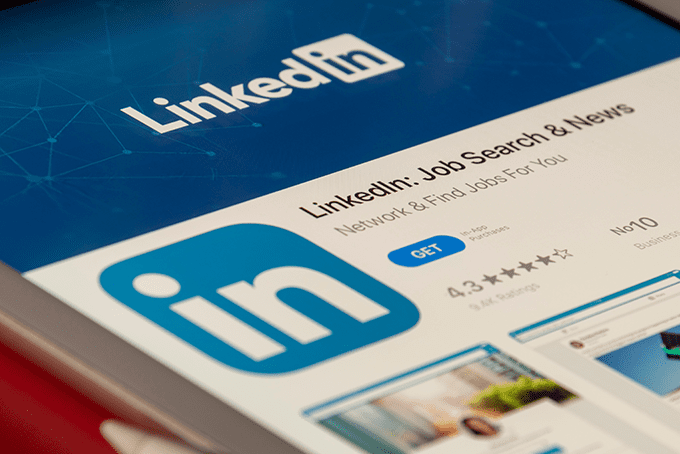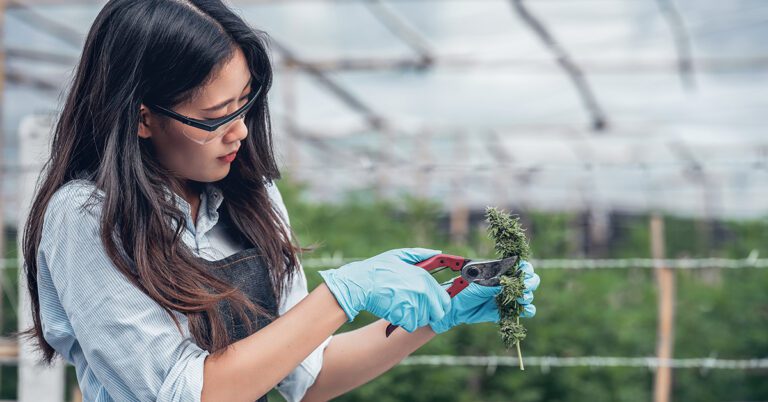Over 420,000 people in America have cannabis jobs, and that number is rising. However, landing a cannabis job can still be quite the challenge. After you optimize your resume and write a captivating cover letter, it would be beneficial to update your LinkedIn profile. One report shows that 67% of companies will look at your LinkedIn profile to consider you for a position. Additionally, 77% of recruiters use LinkedIn to find candidates. Whether you’re looking for jobs on LinkedIn or not, employers and recruiters will look at your LinkedIn profile. To help you in your cannabis job search, we’ve created a list of the best tips for improving your LinkedIn profile. Your narrative is an essential selling point to cannabis employers, so take the time to improve your presence in the digital world.

1. Present Your Personal Brand on Your LinkedIn Profile
When you’re building your personal brand, think about how you want to define yourself to cannabis employers. Answer these three questions: Who are you? What do you want to be known for? What makes you the best choice for the cannabis job you want to land? Consider what sets you apart from others with similar skills and experiences. Also, think about your target audience in the cannabis space and speak to them. After establishing your personal brand, you can project it through your LinkedIn profile. Highlight the skills, experience, and values you bring to the table and how those factors can make a difference for your cannabis target audience. By defining your personal brand, you can establish a strong narrative on LinkedIn, your resume, your cover letter, and other social media channels. Of all the LinkedIn profile tips, this one may be the most important of them all.
2. Use the Right Cannabis Keywords
Cannabis professionals, hiring managers, and recruiters will be running search queries and scoping out your profile. As you would do with your resume, incorporate the right keywords for the cannabis job you’re seeking out. The best LinkedIn profiles utilize the right keywords. The easiest way to do this is by pulling a few cannabis job descriptions for the type of position you want and analyzing what keywords or common themes pop up often. For example, “budtender training” may appear often in a job description for a dispensary store manager. You can even use a keyword density checker to see the most common keywords for the cannabis job description. Also, you can look at the profiles of people who are in the type of cannabis position you want and analyze what keywords and themes they use often.
3. Focus on the Top Section of Your LinkedIn Profile
Hiring managers and cannabis recruiters are busy. Although the best LinkedIn profiles are complete, the top section still may be the most significant part. If you hook viewers in with the top section, they’ll be more inclined to view your entire LinkedIn profile. Therefore, placing your most essential skills, experiences, values, and qualities at the beginning of your profile is crucial. Your headline and profile photo are two things people will see first. If you have a stellar certification or won a prestigious award—don’t wait–mention them early. Additionally, you want to use your most important keywords in the top section. Recruiters and hiring managers trying to fill cannabis jobs will be searching for those keywords, so placing them early in your LinkedIn profile will give you a better chance of popping up at the top of a search query.
4. Mention Your Cannabis Skills/Experience in the About Section
The best LinkedIn profiles have stellar About sections. In your About section, you can give an overview of your brand narrative, including essential skills and experience that help define what you bring to the table. Include the most relevant skills for the cannabis job you want, what you’ve excelled at, and any noteworthy accomplishments. You can also describe what you’re passionate about and why. Here is a basic structure you can utilize for your About section: intro, skills/experience/achievements/mindset, interests, and a Call To Action (CTA). The CTA can be as simple as an invitation to chat about the cannabis industry. Remember to be specific (use numbers when you can), be clear and concise, keep it between 3-5 paragraphs, and don’t forget to let your personality shine.
5. Get Relevant and Strong LinkedIn Recommendations
Just like job references you send along with your resume, recommendations lend more credibility to who you are in a professional sense on LinkedIn. Ask around for recommendations from your past managers and co-workers. To make the process smoother, give them talking points to help tell your personal brand narrative. Also, let them know what skills and experience you want them to mention. The best LinkedIn profiles will have current recommendations. Try and secure new recommendations a few times a year. Requesting endorsements for your skills will also enhance your LinkedIn profile and increase your credibility in the eyes of cannabis employers. Network consistently in the cannabis realm so you can land recommendations from individuals in the industry. Not to mention, you will be more successful in securing recommendations if you give some, too.
6. Complete Your LinkedIn Profile
The best LinkedIn profiles are ones that are complete, as you are more likely to appear in search results if you don’t skip any sections. Also, there’s a high chance that cannabis recruiters and hiring managers will look at your LinkedIn profile whether you apply for jobs on LinkedIn or somewhere else. So completing your profile can only benefit you. Each section of your profile is an opportunity to tell your personal brand narrative and input the right keywords. View your LinkedIn profile and check to see if there are any suggestions for each section. Then, follow any prompts for each section until all parts are filled out. There are many cannabis jobs on LinkedIn, and you will increase your chances of landing one by ensuring your profile is complete.
7. Be an Active LinkedIn Member
Be an active user on the social media platform so that cannabis executives and decision-makers have a better chance to see your personal brand. Comment on posts, engage with users, and write posts or even blogs to share. By being an active user, you can display your expertise in the cannabis industry and connect with professionals in the space. Not to mention, being an active user will help you learn more about the industry, cannabis job you’re pursuing, and potential opportunities that arise. There are 89.3 million monthly active users on LinkedIn, so there’s plenty of potential to make the right connections.
8. Network with Cannabis Professionals
LinkedIn is the best place to network when you’re looking for cannabis jobs. You can connect with people you already know, but you can also request connections from cannabis professionals you don’t know. There are 2 things to remember when sending connection requests:
1) Don’t be lazy and send a connection request without context. Personalize your connection request by explaining why you want to connect, what you hope to get from the connection, and what benefit they’d receive.
2) Make sure your LinkedIn profile is unique and complete before sending the connection request because they’ll likely check out your profile to decide whether they accept or decline.
So who should you connect with? It can help you to connect with people who went to the same university. And they may be in roles you’re pursuing and/or work in the cannabis industry. From there, you may request an informational interview so you can pick their brain about their experience in the space. Additionally, staying active in LinkedIn groups and interacting with group members can help you grow your cannabis network. Not to mention, your posts and comments can be viewed under the “Activity” section, which may be analyzed by hiring managers.
9. Post Cannabis Industry News and Stories
Once your LinkedIn profile is complete, you should make it a daily habit to post cannabis industry news. Through these posts, you can highlight your expertise and build your reputation. Provide your perspective of the news article or thought piece and reinforce your brand narrative. Consistent posting paired with meaningful commentary can elevate your LinkedIn profile and shape you to be a thought leader in the space. Also, with the right hashtags and commentary, you can spark conversations with other cannabis enthusiasts and professionals. The process will keep your feed attracting more eyes to your profile, help you learn more about the cannabis industry, and assist you in making new, worthwhile connections.
10. Update Your Profile Photo
The best LinkedIn profiles have great profile photos. With smartphones packing incredible cameras, you don’t need a professional to take your headshot. However, that doesn’t mean you shouldn’t look professional in your LinkedIn photo. Even if you’re going after cannabis jobs at companies that seem laid back with their attire, you should still dress to impress. Ditch wedding photos or images where you must crop people out. If you have a smartphone, you can get in front of a blank wall and take a good photo. Make sure you’re facing a natural light source, such as a window, and look directly at the camera. It’s easier to make a connection online if people can see your eyes. According to LinkedIn, your face should take up around 60% of the image when it’s cropped.
There are plenty of cannabis industry jobs on LinkedIn. Follow these LinkedIn profile tips and improve your chances of popping up in the right search queries and being seen by the right people.





